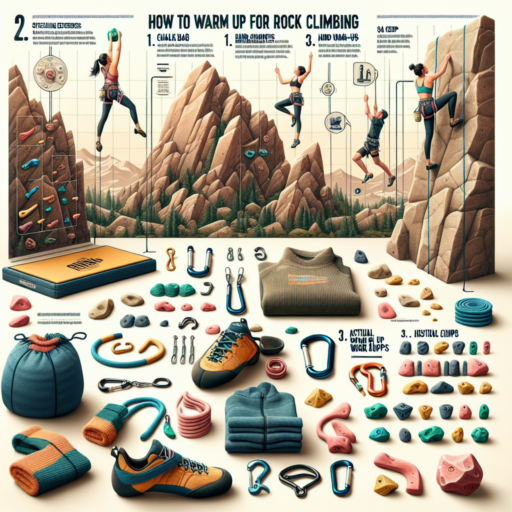How should I warm-up for climbing?
Warming up before climbing is essential for both enhancing performance and preventing injuries. A comprehensive warm-up routine increases your heart rate, improves blood flow to your muscles, and prepares your body and mind for the challenges ahead. To get started, it’s crucial to focus on dynamic stretches rather than static ones, as these movements better mimic the actions you’ll perform while climbing.
Begin with Cardio
Start your warm-up with a short cardiovascular activity. This could be 5-10 minutes of jogging, jumping jacks, or even brisk walking. The goal is to get your heart rate up and your muscles warmed. This phase of warming up is crucial for preparing your body for the more climbing-specific exercises to follow.
Engage in Climbing-Specific Movements
After elevating your heart rate, shift focus to climbing-specific movements. Engage in dynamic stretches such as arm circles, leg swings, and gentle twists of your torso. Activities like these enhance your flexibility and mobility, allowing for a broader range of motion during your climb. Incorporate exercises that simulate climbing movements, focusing on your fingers, wrists, shoulders, and legs, to fully activate the necessary muscle groups.
Remember, warming up is not just about physical readiness, but also about mentally preparing for the climb. Approach your warm-up routine thoughtfully, listening to your body’s needs, and adjusting activities as needed. Starting your climb with a body that’s fully awakened and a mind that’s engaged can significantly impact your climbing efficacy and enjoyment.
No se han encontrado productos.
How do you prepare your body for rock climbing?
Preparing your body for rock climbing involves a combination of exercises aimed at enhancing your strength, endurance, flexibility, and technique. Given the physical demands of rock climbing, it’s crucial to focus on specific areas of your body to ensure you’re ready for the challenge. Here, we explore key practices to get you climb-ready.
Strengthen Your Core and Upper Body
Rock climbing requires a strong core and upper body to support your climbs effectively. Begin with exercises such as planks, pull-ups, and push-ups. These exercises target the essential muscles used during climbing, including your arms, shoulders, back, and abdominal muscles. Incorporating a routine that progressively increases intensity will help build the necessary strength for rock climbing.
Develop Grip Strength and Endurance
Grip strength is fundamental in rock climbing, as it determines your ability to hold onto the rock surface. To enhance your grip, practice exercises like dead hangs from a pull-up bar and use grip strengtheners. Furthermore, building endurance in your forearms through exercises such as boulder problems or longer climbing routes can significantly improve your climbing performance. Remember, the goal is not just to strengthen your grip but to also increase the duration you can maintain that grip during a climb.
Focus on Flexibility and Balance
Flexibility plays a crucial role in enabling climbers to reach challenging holds and maneuver through complicated routes. Engage in regular stretching routines focusing on the legs, hips, and back to improve your flexibility. Yoga can be particularly beneficial for climbers, as it enhances both flexibility and balance—vital components for successful rock climbing. By developing a broader range of motion and learning to maintain balance in precarious positions, climbers can significantly improve their technique and safety on the rock.
How do I prepare for rock climbing for the first time?
Preparing for your first rock climbing experience can feel daunting, but with the right approach, it can turn into an exhilarating adventure. The key is to focus on building a foundation that includes both physical preparation and an understanding of the basics of rock climbing.
Physical Fitness and Training
Start with improving your overall physical fitness. Climbing demands a lot from your body, so incorporating exercises that enhance your strength, flexibility, and endurance is crucial. Focus on exercises that target your core, arms, and legs. Activities such as yoga and swimming can also improve your flexibility and stamina, making you more agile on the climbing wall. Remember, the goal is to condition your body to handle the physical challenges of climbing without overexerting yourself.
Learn the Basics and Gear Up
Educating yourself on the fundamentals of rock climbing is equally important. This includes understanding different climbing techniques, learning how to properly use climbing gear, and familiarizing yourself with safety protocols. Investing time in a climbing course or seeking guidance from experienced climbers can provide valuable insights. Additionally, selecting the right gear is foundational to your climbing journey. Ensure you have a well-fitted harness, climbing shoes, and a helmet to start. It’s crucial these items are comfortable and suited to the type of climbing you’ll be doing.
By focusing on these aspects, you are paving the way for a successful and enjoyable first rock climbing experience. Remember, everyone starts somewhere, and patience combined with persistence will help you achieve your climbing goals.
Should you stretch before rock climbing?
The question of whether to stretch before rock climbing is a topic of much discussion within the climbing community. Stretching, traditionally seen as a fundamental part of any physical activity, plays a crucial role in preparing your body for the challenges ahead. However, it’s essential to distinguish between different types of stretching and understand how they fit into a climber’s routine.
Dynamic stretching is recommended over static stretching before engaging in rock climbing. This involves moving parts of your body and gradually increasing reach, speed of movement, or both. Dynamic stretches such as arm circles, leg swings, and torso twists can help increase blood flow to the muscles, thereby reducing the risk of injury and improving overall performance.
While the consensus leans towards the benefits of dynamic stretching, it’s important to listen to your body. Each climber’s body responds differently to various activities. Incorporating a routine that includes tailored dynamic stretches specific to climbing can significantly enhance flexibility, mobility, and performance. However, static stretching, which involves holding a stretch for a length of time, might be more beneficial post-climb to help with muscle recovery.




